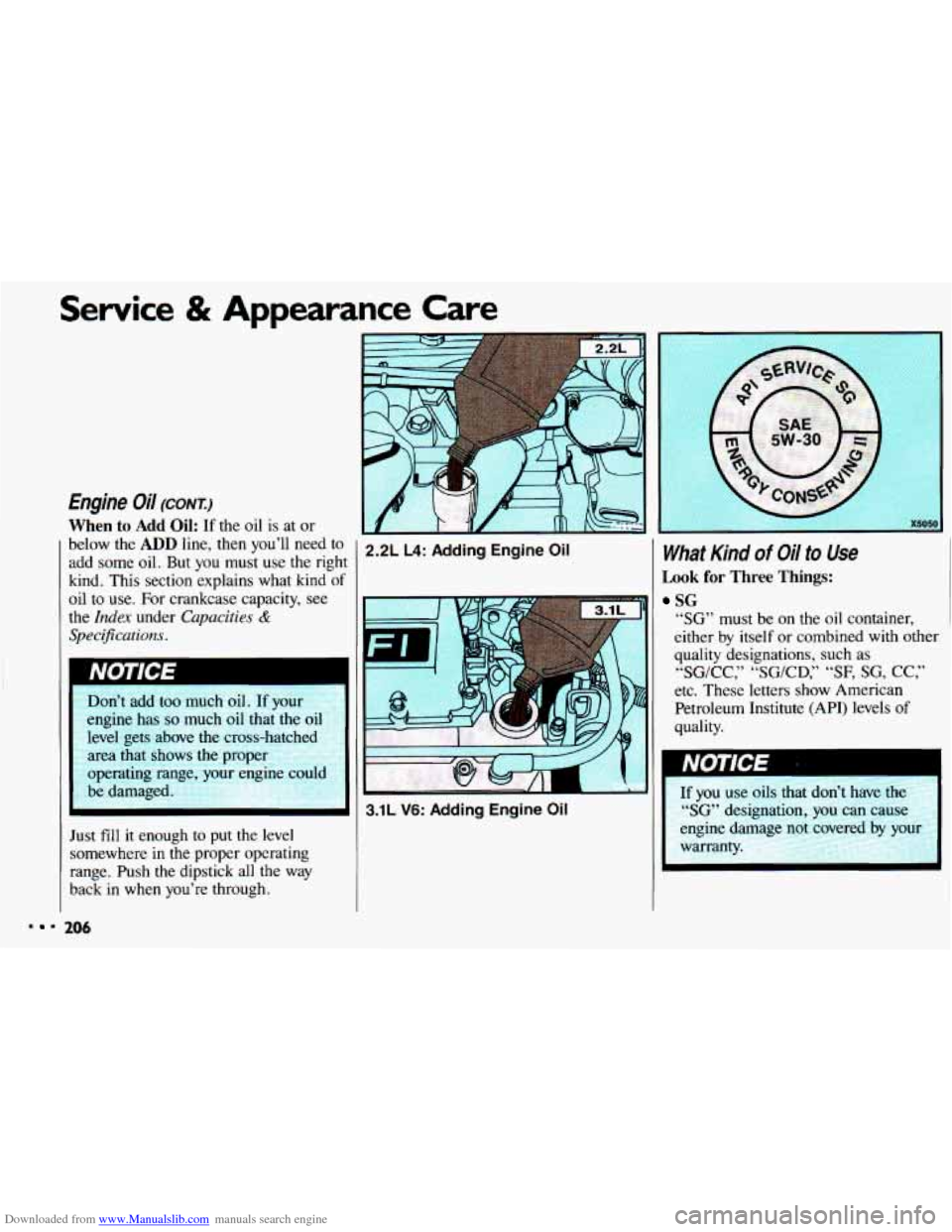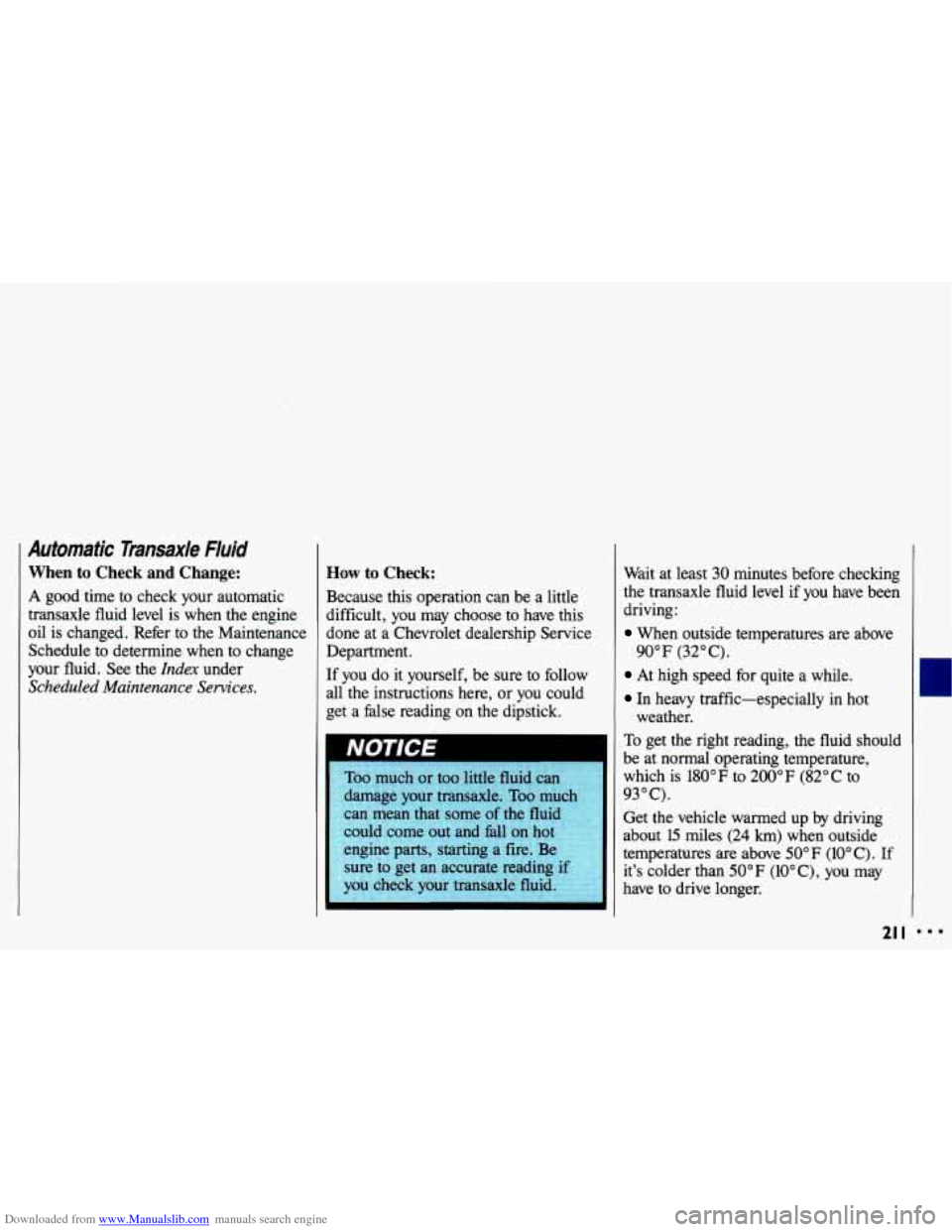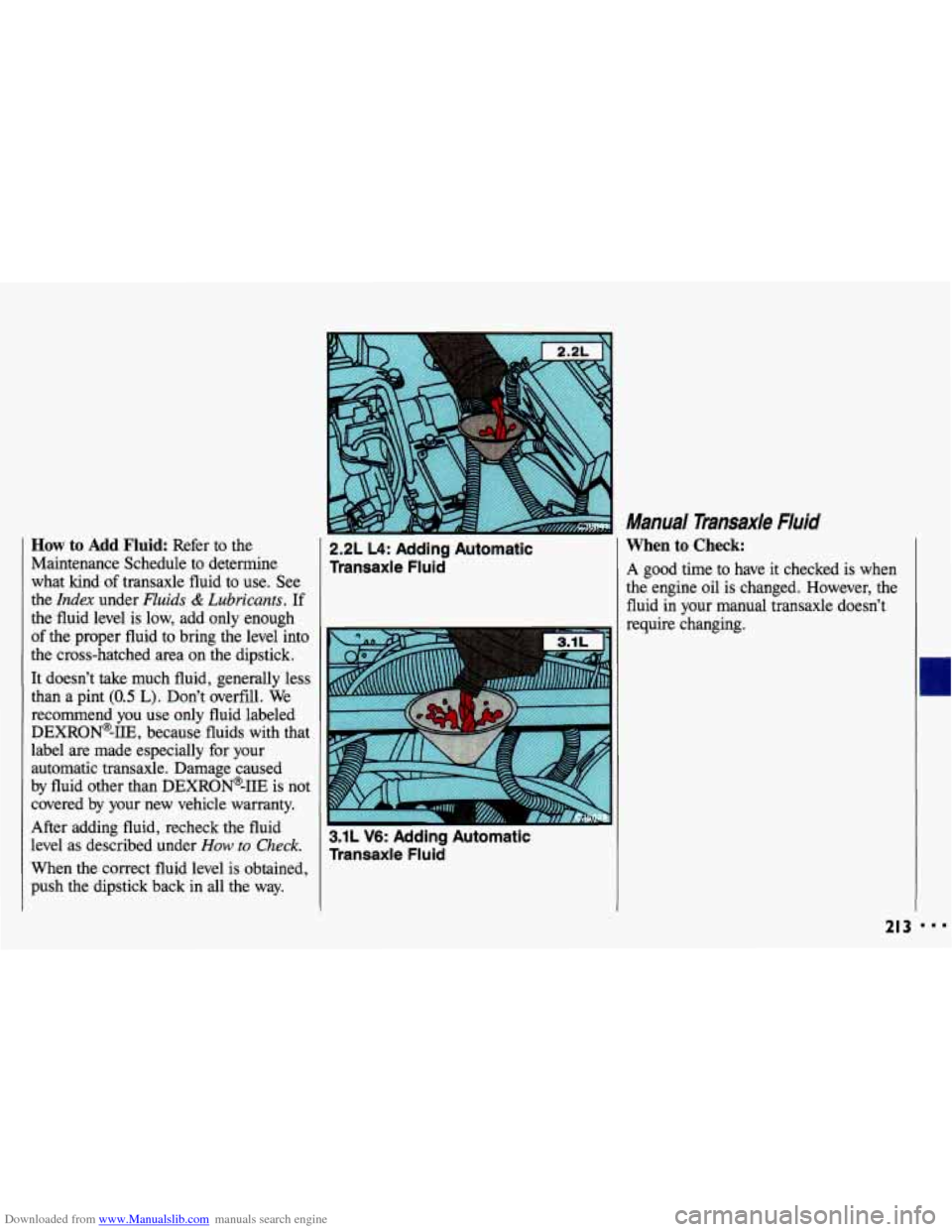Page 205 of 308
Downloaded from www.Manualslib.com manuals search engine d
56053
2.21 L4 Engine (CODE 4)
When you open the hood, you’ll see:
1. Engine Coolant Recovery Tank
2. Power Steering Fluid Reservoir
3. Automatic Transaxle Fluid Dipstick
4. Brake Fluid Reservoir
5. Hydraulic Clutch Fluid Reservoir
6. Windshield Washer Fluid Reservoir
7. Battery
8. Air Cleaner
9. Engine Oil Dipstick
IO. Engine Oil Fill Cap
1 1. Radiator Pressure Cap
(if equipped)
(if equipped)
203
Page 206 of 308
Downloaded from www.Manualslib.com manuals search engine Service & Appearance Care
' 3.11 V6 Engine (CODE T)
1
When you open the hood, you'll see:
1. Coolant Surge Tank
2. Power Steering Fluid Reservoir
3. Automatic Transaxle Fluid Dipstick
4. Brake Fluid Reservoir
5. Hydraulic Clutch Fluid Reservoir
6. Windshield Washer Fluid Reservoir
7. Battery
8. Air Cleaner
9. Engine Oil Fill Cap
10. Engine Oil Dipstick
(if equipped)
(if equipped)
rn 204
Page 207 of 308
Downloaded from www.Manualslib.com manuals search engine Engine Oil
It’s a good idea to check your engine oil
level every time
you get fuel. In order to
get an accurate reading, the
oil must be
warm and the vehicle must be on level
ground.
Turn off the engine and give the oil a
few minutes to drain back into the oil
pan. If you don’t, the oil dipstick might
not show
the actual level.
To Check Engine Oil:
Pull out the dipstick and clean it with a
paper towel or cloth, then push
it back
in all the way. Remove
it again, keeping
the tip lower.
2.2L L4: Checking Engine Oil
3.1L V6: Checking Engine Oil
205 I..
Page 208 of 308

Downloaded from www.Manualslib.com manuals search engine Service & Appearance Care
Engine Oil (CONT.)
When to Add Oil: If the oil is at or
below the ADD line, then you’ll need to
add some oil. But you must use the right
kind. This section explains what kind
of
oil to use. For crankcase capacity, see
the
Index under Capacities &
SpeciBcations.
1
Don’t add too much oil. If your
engine has so much oil that the oil
level gets above the cross-hatched
area that shows the prope
operating range, your engine could
be damaged.
i
Just fill it enough to put the level
somewhere
in the proper operating
range. Push
the dipstick all the way
back
in when you’re through.
2.2L L4: Adding Engine Oil
i-¤
3.1L V6: Adding Engine Oil
What Kind of Oil to Use I
Look for Three Things:
SG
“SG” must be on the oil container,
either
by itself or combined with other
quality designations, such as “SG/CC,” “SG/CD,”
“SF, SG, CC,”
etc. These letters show American
Petroleum Institute (API) levels
of
quality.
If you use oils that don’t have
“SG” designation, you
can cause
engine damage not covered by your
warranty.
= = 206
Page 213 of 308

Downloaded from www.Manualslib.com manuals search engine Automaric Transaxle Fluid
When to Check and Change:
A good time to check your automatic
transaxle fluid level is when the engine
oil is changed. Refer to the Maintenance
Schedule to determine when to change
your fluid. See the
Index under
Scheduled Maintenance Services.
How to Check:
Because this operation can be a little
difficult, you may choose to have this
done at a Chevrolet dealership Service
Department.
If you do it yourself, be sure to follow
all the instructions here, or you could
get a false reading on the dipstick.
Too much or too little fluid can
damage
your transaxle. Too much
can mean that some of the fluid
could come out and fall
on hot
engine parts, starting a fire. Be
sure to get an accurate reading
if
you check your transaxle fluid. Wait
at least 30 minutes before checking
the transaxle fluid level if you have been
driving:
When outside temperatures are above
At high speed for quite a while.
In heavy traffic-especially in hot
To get the right reading, the fluid should
be at normal operating temperature,
which is 180°F to 200°F (82°C to
93" C).
Get the vehicle warmed up by driving
about 15 miles (24
km) when outside
temperatures are above
50°F (10OC). If
it's colder than 50" F (10" C), you may
have to drive longer.
90°F (32°C).
weather.
21 I
Page 215 of 308

Downloaded from www.Manualslib.com manuals search engine How to Add Fluid: Refer to the
Maintenance Schedule to determine
what kind of transaxle fluid to use. See
the
Index under Fluids & Lubricants. If
the fluid level is low, add only enough
of the proper fluid to bring the level into
the cross-hatched area on the dipstick.
It doesn't take much fluid, generally less
than a pint
(0.5 L). Don't overfill. We
recommend you use only fluid labeled
DEXRON@-IIE, because fluids with that
label are made especially for your
automatic transaxle. Damage caused
by fluid other than DEXRON@-IIE is not
covered by your new vehicle warranty.
After adding fluid, recheck the fluid
level as described under
How to Check.
When the correct fluid level is obtained,
push the dipstick back in all the way.
2.2L L4: Adding Automatic
Transaxle Fluid
3.1L V6: Adding Automatic
Transaxle Fluid
Manual Transaxle Fluid
When to Check:
A good time to have it checked is when
the engine oil is changed. However, the
fluid in your manual transaxle doesn't
require changing.
213